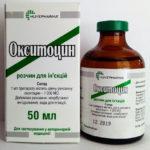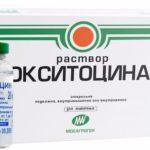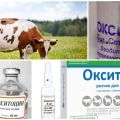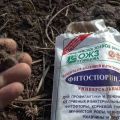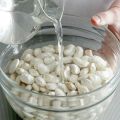Instructions for use and dosage of Oxytocin, when to give the goat and analogues
The veterinary drug "Oxytocin" is used in agriculture to help give birth to animals. This medication is a pharmaceutical analogue of the same name, a hormone synthesized by the hypothalamus, which controls the birth and lactation process. "Oxytocin" is given to the goat to cause the uterine muscles to contract. The injection is given after the exact calculation of the dosage so as not to harm the animal's body.
Composition, active ingredients and release form of the veterinary medicine
A veterinary hormonal preparation is implemented in the form of an injection ampoule solution. The solution looks like a transparent, colorless liquid. Auxiliary components are water and methylparaben preservative. You can buy "Oxytocin" in ampoules of 2, 5, 10, 20 ml, as well as in bottles containing 50 and 100 ml. 1 ml of the drug contains 5 or 10 units of the hormone. The toxicity of the drug is low. If the dosage is observed, "Oxytocin" does not harm the animal.
When should you use it?
The drug "Oxytocin" refers to hormonal agents, in certain cases it is used as an antagonist. The purpose of the hormone is to enhance the contractile function of the uterine muscles. The drug is used for animals that are late in gestation to increase the tone of the uterus, stimulate the labor process and lactation. Oxytocin is frequently given to goats in their late pregnancy.
After the injection, the goat's labor activity is accelerated, and after childbirth, milk is produced more actively, and it passes through the ducts of the mammary glands faster.
Indications for the use of the drug "Oxytocin" in veterinary medicine:
- poorly flowing generic process;
- pathologically weak or absent uterine tone;
- weak progress or stuck fetus in the birth canal;
- insufficient or absent lactation after lambing;
- inflammatory process in the mammary glands, mastitis;
- uterine bleeding;
- inflammatory process in the mucous membranes of the uterus;
- stuck placenta inside the mother after the completion of the labor process.
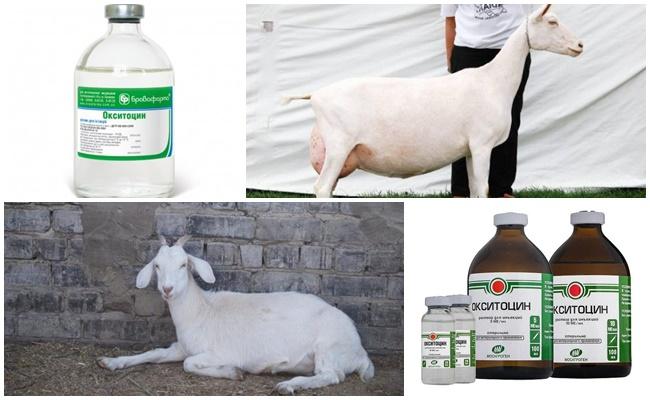
The active effect of the hormonal medication lasts about 45 minutes. If necessary, the veterinarian decides to re-administer oxytocin.
How to use the drug for goats correctly
The instructions for use indicate that subcutaneous, intravenous and intramuscular injections of oxytocin are acceptable. It is permissible to combine the hormone with novocaine, but in veterinary practice this combination is rarely used.The epidural method does not inject oxytocin to goats, which is not very convenient, since with intramuscular injection, the drug is consumed 2 times faster than with an epidural. The intravenous dose for a goat is 2/3 of that injected into the muscle or under the skin, as shown in the table. The hormone begins to act almost instantly. The dosage is given in IU.
| Method of administration | Subcutaneous administration | Intramuscular injection | Vein injection |
| dose | 10-15 | 10-15 | 8-10 |
| speed of action | in 2-3 minutes | in 2 minutes | after 30-60 seconds |
The farmer cannot always call the veterinarian, so he must know how to inject "Oxytocin" on his own to a giving birth goat.
Sequencing:
- Open the ampoule. Fill the syringe with the solution.
- Tie down the goat so that it doesn't kick.
- Find the sacral muscle by touch.
- Gently inject the solution into the muscle tissue.
A goat gives birth from half an hour to 10 hours. The shorter the birth process, the better. If the contractions are weak, the fetus does not move along the birth canal, then insufficient uterine tone should be suspected. That is, the muscles of the uterus cannot cope with the movement of the baby. This phenomenon often happens if the pregnant goat has not been walking enough.
Oxytocin injection is given 10-12 hours after the first contractions. After the baby is born, it is necessary to wait for the placenta to exit. Usually the placenta appears after at least 20 minutes after childbirth, maximum - 4 hours. You can not attempt to pull out the placenta yourself. If it does not come out after the specified time, then oxytocin is administered to the goat.
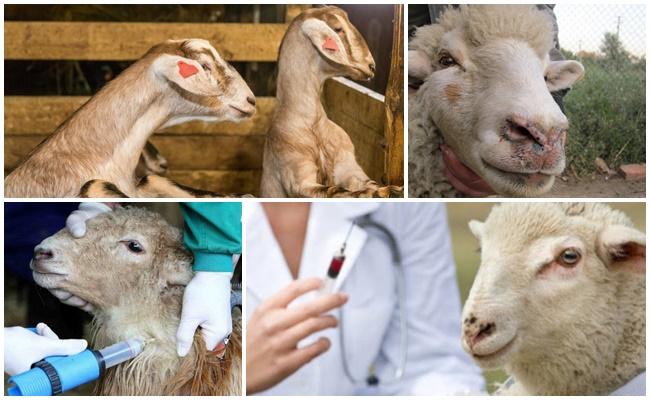
Contraindications and side effects of "Oxytocin"
Oxytocin is a harmless substance when used correctly. So that it does not cause serious harm to the animal, contraindications must be taken into account. It:
- individual intolerance to the hormone;
- renal failure;
- sepsis;
- pathology of the heart and vascular system;
- a narrow pelvis in a goat (requires a cesarean section);
- incorrect position of the baby in the womb (there is a high risk of hypoxia and damage to the uterine cervix);
- physical abnormalities of the fetus, the size of its body, which does not correspond to the patency of the mother's pelvis;
- tumors in the mucous membranes of the uterus;
- deformation of the uterine walls;
- past births performed by cesarean section;
- lactation period in a goat.
If the dose of the drug is exceeded due to excessive tone, uterine bleeding opens. To prevent the fetus from dying, saline is injected intravenously to normalize hormonal balance.
In the absence of individual intolerance and following the instructions for the use of "Oxytocin" side effects are not observed. Otherwise, the following are noted:
- spasms of the muscles surrounding the bronchial branches;
- failure of the rhythm of the heart muscle;
- a strong but short-term drop in blood pressure;
- excessive tension of the smooth uterine muscles;
- allergic reaction.
special instructions
After using oxytocin, you can safely use goat milk and meat. The hormone does not impair the quality of livestock products. In the process of administering the drug to the goat, the employee must not eat, drink, or smoke.
Both before and after all the manipulations carried out, you need to wash your hands with a hygienic product. The syringe used must be sterile. The vials left over after using the solution cannot be taken away for domestic use, they must be disposed of with other glass containers. In case of accidental contact of the solution on the skin or mucous surface of the eyeball, the affected area must be rinsed abundantly with water.

A person who is sensitive to the hormone oxytocin should be careful not to come into contact with hormonal medication. A person who has accidentally swallowed the solution or has encountered an allergic reaction to an active substance should immediately go to a medical facility, taking with him instructions for the use of "Oxytocin".
Storage rules
The drug "Oxytocin" should be stored in a sealed container, in a dry, shaded place, inaccessible to children, where the temperature is not lower than 0 ° C, not higher than +25 ° C. There should be no food and animal feed nearby. The hormonal solution is suitable for 2 years, subject to the storage rules. After depressurization of the container, the unused remains of the drug must be disposed of. Do not use a medication with an expired date.
Analogs
Pharmaceutical manufacturers offer drugs with a similar principle of action:
- "Oxytocin-MEZ";
- Oxytocin-Richter;
- "Syntocinon";
- Oxytocin-VIAL;
- Oxytocin from Grindeks;
- Oxytocin-Ferein;
- "Pitocin".
It is impossible to buy "Oxytocin" in the form of tablets or spray for animals. As tableted analogs, you can name the drugs "Demoxytocin" and "Desaminooxytocin".

